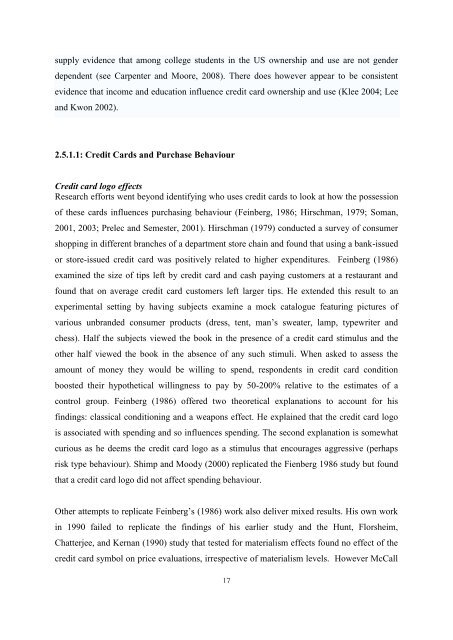Cash or Card: Consumer Perceptions of Payment Modes - Scholarly ...
Cash or Card: Consumer Perceptions of Payment Modes - Scholarly ...
Cash or Card: Consumer Perceptions of Payment Modes - Scholarly ...
You also want an ePaper? Increase the reach of your titles
YUMPU automatically turns print PDFs into web optimized ePapers that Google loves.
supply evidence that among college students in the US ownership and use are not gender<br />
dependent (see Carpenter and Mo<strong>or</strong>e, 2008). There does however appear to be consistent<br />
evidence that income and education influence credit card ownership and use (Klee 2004; Lee<br />
and Kwon 2002).<br />
2.5.1.1: Credit <strong>Card</strong>s and Purchase Behaviour<br />
Credit card logo effects<br />
Research eff<strong>or</strong>ts went beyond identifying who uses credit cards to look at how the possession<br />
<strong>of</strong> these cards influences purchasing behaviour (Feinberg, 1986; Hirschman, 1979; Soman,<br />
2001, 2003; Prelec and Semester, 2001). Hirschman (1979) conducted a survey <strong>of</strong> consumer<br />
shopping in different branches <strong>of</strong> a department st<strong>or</strong>e chain and found that using a bank-issued<br />
<strong>or</strong> st<strong>or</strong>e-issued credit card was positively related to higher expenditures. Feinberg (1986)<br />
examined the size <strong>of</strong> tips left by credit card and cash paying customers at a restaurant and<br />
found that on average credit card customers left larger tips. He extended this result to an<br />
experimental setting by having subjects examine a mock catalogue featuring pictures <strong>of</strong><br />
various unbranded consumer products (dress, tent, man’s sweater, lamp, typewriter and<br />
chess). Half the subjects viewed the book in the presence <strong>of</strong> a credit card stimulus and the<br />
other half viewed the book in the absence <strong>of</strong> any such stimuli. When asked to assess the<br />
amount <strong>of</strong> money they would be willing to spend, respondents in credit card condition<br />
boosted their hypothetical willingness to pay by 50-200% relative to the estimates <strong>of</strong> a<br />
control group. Feinberg (1986) <strong>of</strong>fered two the<strong>or</strong>etical explanations to account f<strong>or</strong> his<br />
findings: classical conditioning and a weapons effect. He explained that the credit card logo<br />
is associated with spending and so influences spending. The second explanation is somewhat<br />
curious as he deems the credit card logo as a stimulus that encourages aggressive (perhaps<br />
risk type behaviour). Shimp and Moody (2000) replicated the Fienberg 1986 study but found<br />
that a credit card logo did not affect spending behaviour.<br />
Other attempts to replicate Feinberg’s (1986) w<strong>or</strong>k also deliver mixed results. His own w<strong>or</strong>k<br />
in 1990 failed to replicate the findings <strong>of</strong> his earlier study and the Hunt, Fl<strong>or</strong>sheim,<br />
Chatterjee, and Kernan (1990) study that tested f<strong>or</strong> materialism effects found no effect <strong>of</strong> the<br />
credit card symbol on price evaluations, irrespective <strong>of</strong> materialism levels. However McCall<br />
17

















